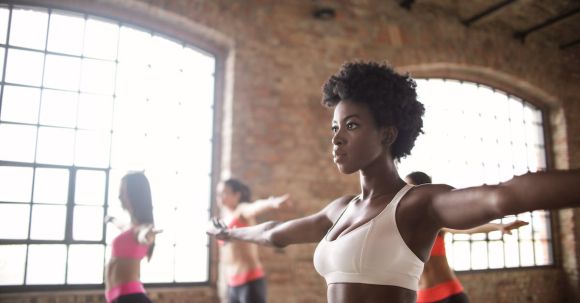Powerlifting is a sport that tests your limits, pushes your boundaries, and allows you to showcase your strength like never before. If you have been working hard in the gym, honing your skills, and are ready to take on a new challenge, participating in a powerlifting competition may be just what you need. This article will guide you through the process of preparing for and competing in a powerlifting competition, helping you to master your strength and achieve your goals.
Blog Posts
Yoga is not just a physical exercise; it is a journey towards self-discovery and inner growth. Whether you are a beginner or have been practicing for years, there are always ways to take your yoga practice to a deeper level. Here are some effective techniques to help you deepen your yoga practice and experience its transformative power.
Set an Intention
Before you begin your yoga practice, take a moment to set an intention for your session. This can be a simple affirmation or mantra that resonates with you. By setting an intention, you create a focus for your practice and align your mind and body towards a specific goal. It could be something as simple as "I am present and open to the wisdom of my body" or "I am cultivating inner peace and balance." Setting an intention helps you stay connected to your practice and brings a sense of purpose to your yoga journey.Explore Different Styles
Yoga is a vast discipline with various styles and approaches. To deepen your practice, explore different styles of yoga and find the ones that resonate with you. Try a gentle and restorative class to nurture your body and mind, or challenge yourself with a vigorous vinyasa flow. Each style offers unique benefits and can help you develop different aspects of your practice. By exploring different styles, you can broaden your understanding of yoga and discover new ways to connect with yourself.Practice Mindful Breathing
Breath is the foundation of yoga. By practicing mindful breathing, you can deepen your awareness and enhance the benefits of your practice. During your yoga session, pay attention to your breath and let it guide your movements. Take slow, deep breaths, and focus on the sensation of the breath entering and leaving your body. This not only helps you stay present in the moment but also brings a sense of calm and clarity to your practice. Mindful breathing allows you to connect with the subtle energy within you and create a deeper sense of unity between your body, mind, and breath.Cultivate a Meditation Practice
Meditation and yoga go hand in hand. By incorporating meditation into your yoga practice, you can deepen your connection with yourself and experience a greater sense of inner peace. Set aside a few minutes each day to sit in stillness and observe your thoughts without judgment. Start with just a few minutes and gradually increase the duration as you become more comfortable. Meditation helps quiet the mind, increase self-awareness, and cultivate a deep sense of presence. By integrating meditation into your yoga practice, you can experience a more profound and transformative journey.Find Inspiration
Sometimes, we all need a little inspiration to keep our yoga practice alive and vibrant. Seek out books, podcasts, or videos by experienced yogis who inspire you. Attend workshops or retreats to learn from seasoned teachers and connect with a community of like-minded individuals. Surrounding yourself with inspiration and support can fuel your passion for yoga and deepen your practice. Remember, yoga is a lifelong journey, and there is always room for growth and exploration. In conclusion, deepening your yoga practice is about more than just physical postures. It is a holistic journey that involves setting intentions, exploring different styles, practicing mindful breathing, cultivating a meditation practice, and finding inspiration. By incorporating these techniques into your yoga routine, you can tap into the transformative power of yoga and experience a deeper connection with yourself. Embrace the journey, stay curious, and let your yoga practice become a transformative force in your life.
When it comes to excelling in sports, it's not just about having the right skills and techniques. It's also about having a strong and powerful body that can handle the demands of the game. That's where sports-specific exercises come in. By tailoring your training to the specific demands of your sport, you can enhance your performance and take your game to the next level. In this article, we will delve into the importance of sports-specific exercises and explore some examples that can power up your play.
Understanding the Importance of Sports-specific Exercises
Sports-specific exercises are designed to mimic the movements and requirements of your chosen sport. By focusing on the specific muscles and energy systems used in your sport, these exercises can help you develop the strength, endurance, and agility needed to excel on the field, court, or track.The Benefits of Sports-specific Exercises
1. Improved Performance: By training using exercises that closely replicate the movements of your sport, you can improve your performance in specific areas. For example, a basketball player can work on their vertical jump, while a tennis player can focus on rotational power. 2. Injury Prevention: Sports-specific exercises can also help prevent injuries by strengthening the muscles and joints used in your sport. By targeting weak areas and improving your overall strength and stability, you can reduce the risk of common sports injuries. 3. Increased Efficiency: Sports-specific exercises can also help you become more efficient in your movements. By training your body to move in the most effective and efficient way for your sport, you can conserve energy and improve your overall endurance.Sports-specific Exercises for Different Sports
1. Soccer: Soccer players can benefit from exercises that focus on agility, speed, and lower body strength. Examples include ladder drills, cone drills, and single-leg squats. 2. Tennis: Tennis players can improve their power and endurance by incorporating exercises that focus on rotational movements and core strength. Examples include medicine ball twists, Russian twists, and planks. 3. Basketball: Basketball players can enhance their vertical jump and explosive power with exercises such as box jumps, jump squats, and plyometric push-ups. 4. Swimming: Swimmers can benefit from exercises that strengthen their upper body and core muscles. Examples include pull-ups, medicine ball throws, and flutter kicks. 5. Running: Runners can improve their speed and endurance with exercises that focus on leg strength and cardiovascular fitness. Examples include hill sprints, lunges, and interval training.Incorporating Sports-specific Exercises into Your Training
To incorporate sports-specific exercises into your training, it's important to first identify the specific movements and muscle groups used in your sport. Once you have a clear understanding of these requirements, you can design a training program that targets these areas. Start by incorporating a mix of strength training, plyometrics, and agility drills into your workouts. Gradually increase the intensity and difficulty of your exercises as your strength and fitness improve. Remember to also include rest days and recovery techniques in your training program to allow your body to repair and rebuild. This will help prevent overuse injuries and ensure that you're able to perform at your best on game day. In conclusion, sports-specific exercises are a crucial component of any athlete's training program. By tailoring your workouts to the specific demands of your sport, you can enhance your performance, prevent injuries, and increase your overall efficiency. So, power up your play by incorporating sports-specific exercises into your training routine and watch your game reach new heights.
We all strive to feel confident and have high self-esteem. It affects how we perceive ourselves and how we interact with others. One powerful tool that can help in boosting confidence and self-esteem is physical fitness. Fit On, a popular fitness app, provides a wide range of workouts and features that can help you on this journey. In this article, we will explore how Fit On can contribute to enhancing your confidence and self-esteem.
Discover Your Strengths through Exercise
Regular exercise helps you discover your physical strengths and capabilities. Fit On offers a variety of workout programs, from cardio to strength training and yoga. By engaging in these workouts, you can challenge yourself and push your limits. As you progress and achieve new milestones, you will realize the strength and power within you. This newfound physical strength translates into a sense of empowerment and confidence that extends beyond the gym.Improve Your Body Image
Body image plays a significant role in how we perceive ourselves. Fit On provides a platform where you can work on improving your body image in a healthy and positive way. Through its diverse workout programs, you can target different areas of your body and work towards your fitness goals. As you witness your body becoming stronger, leaner, and more toned, you will develop a more positive perception of yourself. This positive body image can significantly boost your confidence and self-esteem.Set Achievable Goals and Track Progress
Setting achievable goals is crucial for building confidence. Fit On allows you to set specific fitness goals and track your progress along the way. Whether you want to run a certain distance, lift a certain weight, or master a challenging yoga pose, Fit On provides the guidance and tracking tools to help you achieve these goals. As you witness yourself progressing and achieving milestones, your confidence in your abilities will soar. This newfound belief in yourself will extend beyond fitness, positively impacting other aspects of your life.Enhance Mental Well-being
Physical fitness is not just about the body; it also greatly benefits the mind. Fit On not only offers physical workouts but also includes meditation and mindfulness sessions. Engaging in these practices can help reduce stress, improve focus, and boost overall mental well-being. When your mind is calm and focused, you are better equipped to face challenges and believe in your abilities. This mental resilience translates into increased confidence and self-esteem.Build a Supportive Community
Fit On provides a platform where you can connect with like-minded individuals who share similar fitness goals. The app offers features such as live classes and community forums where you can interact with fitness enthusiasts from around the world. Being a part of a supportive community can be incredibly motivating and empowering. You can share your progress, seek advice, and celebrate each other's achievements. This sense of belonging and support can significantly boost your confidence and self-esteem.Conclusion: Embrace the Power of Fit On
Boosting your confidence and self-esteem is a journey that requires dedication and the right tools. Fit On offers a comprehensive platform that combines physical fitness, mental well-being, and a supportive community. By incorporating Fit On into your lifestyle, you can discover your strengths, improve your body image, achieve fitness goals, enhance mental well-being, and build a supportive community. Embrace the power of Fit On and watch your confidence and self-esteem soar to new heights.
Yoga has become increasingly popular in recent years, and for good reason. It offers a wide range of physical and mental benefits, making it a great addition to any fitness routine. If you've been curious about trying yoga but aren't sure how to incorporate it into your current workout regimen, look no further. In this article, we will explore some simple and effective ways to seamlessly blend yoga into your fitness routine.
1. Start with a Warm-Up
Just like any other workout, it's important to warm up your body before diving into a yoga practice. Begin with a few minutes of gentle stretching or light cardio to get your blood flowing and loosen up your muscles. This will help prepare your body for the more intense movements and stretches involved in yoga.2. Mix and Match
One of the great things about yoga is its versatility. You can easily mix and match different styles and poses to create a workout that suits your needs. If you're looking to build strength, incorporate some power yoga poses into your routine. For a more relaxing experience, try some restorative yoga poses to help you unwind and de-stress. The key is to experiment and find what works best for you.3. Pair Yoga with Cardio
If you're someone who enjoys cardio workouts like running or cycling, consider adding a yoga session to your routine. Yoga can help improve your flexibility and balance, which can enhance your performance in other activities. Plus, it provides a low-impact option for active recovery days, allowing your body to rest and rejuvenate while still getting some movement in.4. Focus on Specific Areas
Yoga offers a range of poses that target different areas of the body. If you have specific goals or areas you'd like to work on, incorporate poses that focus on those areas into your routine. For example, if you want to strengthen your core, include some plank poses or boat poses. If you're looking to improve your balance, incorporate tree pose or warrior III into your practice.5. Don't Forget about the Mind-Body Connection
One of the unique aspects of yoga is its emphasis on the mind-body connection. Take advantage of this by incorporating mindfulness and meditation into your practice. Set aside a few minutes at the beginning or end of your yoga session to focus on your breath and clear your mind. This can help reduce stress, improve mental clarity, and enhance your overall well-being.6. Make it a Habit
Consistency is key when it comes to any fitness routine, and yoga is no exception. Aim to incorporate yoga into your routine at least a few times a week. Whether you prefer to practice in a studio, at home, or outdoors, find a time and place that works best for you. By making yoga a regular part of your fitness routine, you'll start to experience the numerous benefits it has to offer. Incorporating yoga into your fitness routine doesn't have to be complicated. By following these simple tips, you can seamlessly blend yoga into your current workout regimen and reap the many physical and mental benefits it provides. So why wait? Roll out your mat, take a deep breath, and get ready to embark on a journey of strength, flexibility, and mindfulness. Your body and mind will thank you.
Yoga is a powerful practice that combines physical postures, breathing techniques, and meditation to promote overall well-being. While yoga alone can help you build strength and flexibility, incorporating strength training into your yoga practice can take your physical fitness to the next level. In this article, we will explore how you can effectively integrate strength training into your yoga routine for optimal results.
Understanding the Benefits of Strength Training in Yoga
Strength training involves using resistance to build muscular strength and endurance. By incorporating strength training into your yoga practice, you can enhance your performance in various yoga poses, improve your muscle tone, and prevent injuries. Additionally, strength training can help you develop a strong core, which is essential for maintaining stability and balance in your yoga practice.Targeted Strength Training Exercises for Yogis
To incorporate strength training into your yoga practice, it is essential to focus on exercises that target the major muscle groups used in yoga. Here are some effective strength training exercises for yogis:1. Plank Pose
Plank pose is a great exercise to strengthen your core, arms, and shoulders. Start by assuming a push-up position and hold it for as long as you can. As you progress, you can challenge yourself by lifting one leg or arm off the ground while maintaining a stable plank position.2. Chair Pose Squats
Chair pose squats are an excellent way to strengthen your legs and glutes. Begin by assuming the chair pose, with your knees bent and your thighs parallel to the ground. From this position, perform squats by lowering your hips towards the ground and then rising back up. Repeat this movement for several repetitions.3. Side Plank with Leg Lifts
Side plank with leg lifts is an effective exercise for strengthening your obliques, hips, and legs. Start in a side plank position with your forearm on the ground and your body in a straight line. Lift your top leg towards the ceiling and then lower it back down. Repeat this movement for several repetitions before switching sides.4. Bridge Pose with Leg Extension
Bridge pose with leg extension is a challenging exercise that targets your glutes, hamstrings, and core. Begin by lying on your back with your knees bent and feet flat on the ground. Lift your hips off the ground into a bridge position and extend one leg straight out in front of you. Hold this position for a few seconds before lowering your leg and repeating on the other side.Integrating Strength Training into Your Yoga Routine
Now that you know some effective strength training exercises for yogis, it's time to integrate them into your yoga routine. Here are some tips to help you get started:1. Warm-up Before Strength Training
Before incorporating strength training exercises into your yoga practice, warm up your body with some gentle stretches and dynamic movements. This will help prepare your muscles for the added resistance and reduce the risk of injury.2. Start Slowly and Progress Gradually
When starting with strength training, it's important to begin with lighter weights or resistance and gradually increase the intensity as your strength improves. Listen to your body and avoid pushing yourself too hard too soon. Remember, consistency is key when it comes to building strength.3. Alternate Strength Training and Yoga Sessions
To avoid overtraining and give your muscles time to recover, alternate your strength training and yoga sessions. For example, you could dedicate three days a week to strength training and the other three days to your regular yoga practice. This will ensure that you are giving equal attention to both aspects of your fitness routine.4. Modify Yoga Poses to Add Resistance
To incorporate strength training into your yoga practice, you can modify certain yoga poses to add resistance. For example, you can hold light dumbbells or use resistance bands while performing warrior poses or lunges. This will challenge your muscles and make your yoga practice more strength-oriented. In conclusion, incorporating strength training into your yoga practice can enhance your physical fitness and take your yoga journey to new heights. By targeting the major muscle groups used in yoga and integrating strength training exercises into your routine, you can build strength, improve muscle tone, and prevent injuries. Remember to start slowly, progress gradually, and listen to your body. With consistency and dedication, you will reap the benefits of a well-rounded yoga practice that incorporates strength training.Transform Your Body in 30 Days with the Fit on Challenge
Are you tired of feeling sluggish, unmotivated, and unhappy with your body? Do you want to see real results and feel confident in your own skin? Look no further than the Fit on Challenge – a 30-day program designed to transform your body and improve your overall well-being. With this challenge, you can say goodbye to your old habits and hello to a healthier, fitter you!Setting Goals: The Key to Success
Before embarking on any fitness journey, it's important to set clear and realistic goals. Take some time to reflect on what you want to achieve during the Fit on Challenge. Is it weight loss, increased muscle tone, or improved endurance? Whatever it may be, write it down and commit to it. Having a clear goal in mind will help you stay focused and motivated throughout the challenge.Revamping Your Diet: Fuel Your Body Right
One of the most crucial aspects of any body transformation is your diet. It's time to ditch the processed junk food and embrace whole, nutrient-dense foods. Fill your plate with lean proteins, colorful fruits and vegetables, and healthy fats. Don't forget to drink plenty of water to stay hydrated throughout the day. By nourishing your body with the right foods, you'll have the energy you need to power through your workouts and see results faster.Sweat it Out: Fitness and Exercise
No body transformation is complete without regular exercise. Choose activities that you enjoy and that challenge your body. Whether it's running, weightlifting, dancing, or yoga, find something that gets your heart rate up and makes you break a sweat. Aim for at least 30 minutes of moderate to intense exercise five days a week. Remember, consistency is key, so make sure to stick to your workout routine.Track Your Progress: Stay Accountable
To stay motivated and track your progress, it's essential to keep a record of your workouts, meals, and measurements. This will help you see how far you've come and keep you accountable during the Fit on Challenge. Take photos of yourself at the beginning of the challenge and compare them to your progress photos at the end. You'll be amazed at the changes you see in just 30 days!Find a Support System: Team up for Success
Embarking on a body transformation journey can be challenging, so it's important to have a support system in place. Find a workout buddy or join a fitness community where you can share your goals, struggles, and triumphs. Surrounding yourself with like-minded individuals will keep you motivated and inspired to push through any obstacles that come your way.The Power of Rest and Recovery
While pushing yourself during workouts is important, so is giving your body time to rest and recover. Make sure to incorporate rest days into your fitness routine to allow your muscles to repair and grow. Focus on getting quality sleep, as it plays a crucial role in your overall well-being and recovery. Taking care of your body both inside and out will ensure you see the best results from the Fit on Challenge. Celebrate Your Achievements: You Did It! At the end of the 30 days, take a moment to celebrate your achievements. Reflect on how far you've come and how your body and mind have transformed. Whether you've reached your initial goal or not, remember that the Fit on Challenge is just the beginning of a lifetime of health and fitness. Use this experience as a stepping stone to continue making positive changes in your life. In conclusion, the Fit on Challenge is a 30-day program that can transform your body and improve your overall well-being. By setting clear goals, revamping your diet, incorporating regular exercise, tracking your progress, finding a support system, prioritizing rest and recovery, and celebrating your achievements, you'll be well on your way to becoming a healthier, fitter version of yourself. Take the challenge and see what you're capable of – the results may surprise you!
Strength training, also known as resistance training, has become increasingly popular among individuals looking to achieve their weight loss goals. While many people associate cardiovascular exercise with weight loss, strength training has its own unique benefits when it comes to shedding those extra pounds. In this article, we will explore the various ways in which strength training can aid in weight loss.
Building Lean Muscle Mass
One of the key benefits of strength training is its ability to help build lean muscle mass. Unlike cardio exercises that primarily focus on burning calories during the workout itself, strength training increases muscle mass, which in turn boosts your metabolism. This means that you will continue to burn calories even after your workout is complete. The more lean muscle mass you have, the higher your resting metabolic rate will be, resulting in more calories burned throughout the day.Increasing Caloric Expenditure
Strength training is an effective way to increase your overall caloric expenditure. When you engage in resistance exercises, your muscles require energy to perform the movements. This energy comes from burning calories. In fact, studies have shown that strength training can increase your metabolic rate for up to 48 hours after a workout. This means that even when you are at rest, your body will be burning more calories than it would without the added muscle mass.Enhancing Fat Burning
Contrary to popular belief, strength training can be just as effective, if not more so, at burning fat compared to cardio exercises. While cardiovascular workouts predominantly burn calories during the exercise session, strength training has been shown to have a longer-lasting effect on fat burning. By increasing muscle mass through resistance exercises, your body becomes more efficient at utilizing stored fat as a source of energy. This means that even when you are not actively exercising, your body will be tapping into its fat stores to fuel your daily activities.Improving Insulin Sensitivity
Strength training has been found to improve insulin sensitivity, which is crucial for weight loss. Insulin is a hormone that regulates blood sugar levels and plays a key role in fat storage. When your body becomes more sensitive to insulin, it can more effectively utilize the carbohydrates you consume as energy, rather than storing them as fat. This can help prevent weight gain and promote weight loss.Maintaining Muscle Mass during Weight Loss
When you are trying to lose weight, it is important to preserve your muscle mass. Many traditional weight loss methods, such as crash diets or excessive cardio, can result in muscle loss along with fat loss. However, incorporating strength training into your weight loss routine can help prevent this muscle loss. By engaging in resistance exercises, you can maintain and even increase your muscle mass while shedding unwanted pounds. In conclusion, strength training is not just for building muscle and strength. It can also be a valuable tool in achieving weight loss goals. By increasing lean muscle mass, boosting caloric expenditure, enhancing fat burning, improving insulin sensitivity, and preserving muscle mass, strength training offers a range of benefits that can aid in weight loss efforts. So, if you are looking to shed those extra pounds, consider incorporating resistance exercises into your fitness routine and experience the transformative effects of strength training.
When it comes to exercise, there are many options to choose from. From cardio workouts to yoga classes, the possibilities are endless. However, one form of exercise that often gets overlooked is resistance training. Incorporating resistance training into your routine can have numerous benefits for your overall health and fitness. In this article, we will explore some of these benefits and why you should consider adding resistance training to your workout regimen.
Improved Muscle Strength and Tone
One of the primary benefits of resistance training is improved muscle strength and tone. By using resistance, such as weights or resistance bands, you are challenging your muscles to work harder. Over time, this leads to an increase in muscle strength and definition. Resistance training can target specific muscle groups, allowing you to focus on areas that you want to tone and strengthen. Whether it's your arms, legs, or core, resistance training can help you achieve the sculpted physique you desire.Increased Bone Density
Another advantage of resistance training is increased bone density. As we age, our bones naturally become weaker and more prone to fractures. However, resistance training can help combat this. When you perform weight-bearing exercises, such as squats or lunges, you are putting stress on your bones. This stress stimulates the production of new bone cells, leading to increased bone density. By incorporating resistance training into your routine, you can help prevent conditions like osteoporosis and maintain strong, healthy bones.Boosted Metabolism
Resistance training can also have a positive impact on your metabolism. Unlike cardio exercises that primarily burn calories during the workout itself, resistance training can help increase your metabolic rate even after you've finished exercising. This is because resistance training builds lean muscle mass, which requires more energy to maintain. The more lean muscle mass you have, the higher your basal metabolic rate. This means that your body will burn more calories at rest, making it easier to maintain a healthy weight and body composition.Improved Mental Health
Exercise has long been known to have positive effects on mental health, and resistance training is no exception. When you engage in resistance training, your body releases endorphins, also known as "feel-good" hormones. These endorphins can help improve your mood, reduce stress, and alleviate symptoms of anxiety and depression. Additionally, resistance training can boost your self-confidence and body image, leading to improved overall mental well-being.Enhanced Functional Fitness
Resistance training can also improve your functional fitness, which refers to your ability to perform everyday tasks with ease. By incorporating exercises that mimic real-life movements, such as squats, lunges, and deadlifts, you can improve your strength and stability in a way that directly translates to everyday activities. Whether it's carrying groceries, climbing stairs, or playing with your kids, resistance training can help you perform these tasks more efficiently and with less risk of injury.Incorporating Resistance Training into Your Routine
Now that you understand the benefits of resistance training, you may be wondering how to incorporate it into your routine. The good news is that there are numerous ways to do so. You can join a gym and use weight machines or free weights, take a resistance training class, or even incorporate bodyweight exercises into your home workouts. It's important to start slowly and gradually increase the intensity and resistance as your strength improves. In conclusion, resistance training offers a multitude of benefits for your physical and mental well-being. From improved muscle strength and tone to increased bone density and a boosted metabolism, the advantages are clear. So why not give it a try? Incorporate resistance training into your routine and reap the rewards of a stronger, healthier body.
Squatting is a fundamental exercise that targets multiple muscle groups and is a staple in many fitness routines. However, executing the squat properly can be challenging, and improper technique can lead to injuries or hinder your progress. In this article, we will discuss effective strategies to improve your squatting technique, allowing you to maximize your gains and minimize the risk of injuries.









